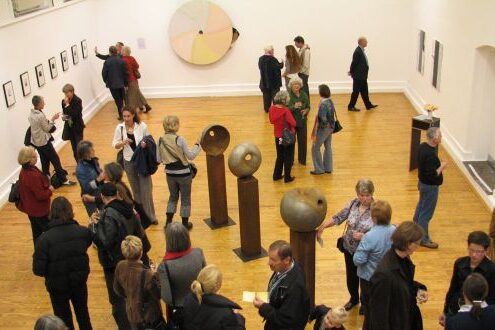BBK Wiesbaden e. V.
Founded in 1955, the BBK Wiesbaden is now based in the Kunsthaus on the Schulberg. This is where the activities of the association, which sees itself as a lobbyist for the interests of artists, are concentrated. As an intermediary between them and the art-interested public, it offers a directory of Wiesbaden studios on the Internet.
The Berufsverband Bildender Künstlerinnen und Künstler Wiesbaden e. V., BBK Wiesbaden e. V. for short, is part of the nationally organized professional association that represents the interests of artists vis-à-vis political bodies.
The BBK at federal level is the largest European artists' association and sees itself as a lobbyist for the entire German artistic community with the aim of representing and taking into account their professional interests in society. These include issues such as fees, health and accident insurance, exhibition and work opportunities. The reduced VAT rate for works of art (7% instead of 19%), social insurance for artists (since 1981), the collecting society Bild-Kunst, copyright, art-in-architecture programs and much more are achievements of the BBK, which has existed nationwide since 1949.
The BBK is characterized by tolerance towards all art forms. All artistic disciplines and styles are represented. Graduates of an art academy as well as applicants who can prove their professionalism in the field of art by submitting their work to a five-member independent jury are accepted. The individual district and regional associations work independently.
The BBK Wiesbaden was founded in 1955. Lively artistic activities by Wiesbaden painters and sculptors (including the Ring Bildender Künstler Wiesbaden, the Gruppe 50, now the Künstlergruppe 50 Wiesbaden, the Künstlerbund and the Künstlerkreis) preceded this founding meeting, which was well attended by 50 interested parties. Today's honorary members Ernst Dostal, Christa Moering († 2013) and Wolf Spemann were among the 38 first to attend and spontaneously register on June 18, 1955 at 5 p.m. in the lecture hall of the Wiesbaden Museum.
In 1978, the BBK Wiesbaden had 148 members, but hardly any studios. When the building of the former Werkkunstschule at Schulberg 10 became vacant in 1982, a tug-of-war began over its future use. This lasted five years before Helmut Schulze-Reichenberg launched a circular call among like-minded colleagues and quickly occupied the building with them. That same year, a large exhibition was held in the assembly hall. Rooms in the main building and the annexe were immediately used as studios.
The very next year, an "open studio day" offered interested members of the public the opportunity to see for themselves that good work was being done in the newly established art house. Numerous exhibitions, art talks, seminars, festivals and the "Art in the Vineyard" symposium have since borne witness to the activities of the BBK, which was awarded the "Wiesbaden Tusculum Prize for Visual Artists" in 1995, donated by the reciter and gallery owner Heinz Nied.
The BBK board consists of three people who work on a voluntary basis. The board meetings are open to all members. The office is located in the Kunsthaus Wiesbaden. It is a center of active networking. This is where calls for proposals are received and forwarded to members, where the board meets regularly and where members meet to discuss current issues. Gallery owners and municipal committees as well as businesses and public institutions are in contact with the artists.
The diverse contacts with colleagues from other federal states and partner cities result in exhibition projects, which are usually presented in the auditorium in the fall. At the beginning of each year, new members present their work in these rooms.
In order to continue to fulfill its role as an intermediary between the artistic community and the art-interested public, the BBK has published a studio directory of Wiesbaden artists online at www.kuenstler-in-wiesbaden.de.
Literature
- Berufsverband Bildender Künstlerinnen und Künstler Wiesbaden e. V.(Hrsg.)
BBK Wiesbaden 1955 - 1995, Wiesbaden 1995.
- Berufsverband Bildender Künstlerinnen und Künstler Wiesbaden e. V.(Hrsg.)
Zeitzeichen - Zeitgleich - Fall 2010 Art & Dialog. Art in the city, Wiesbaden 2010.
